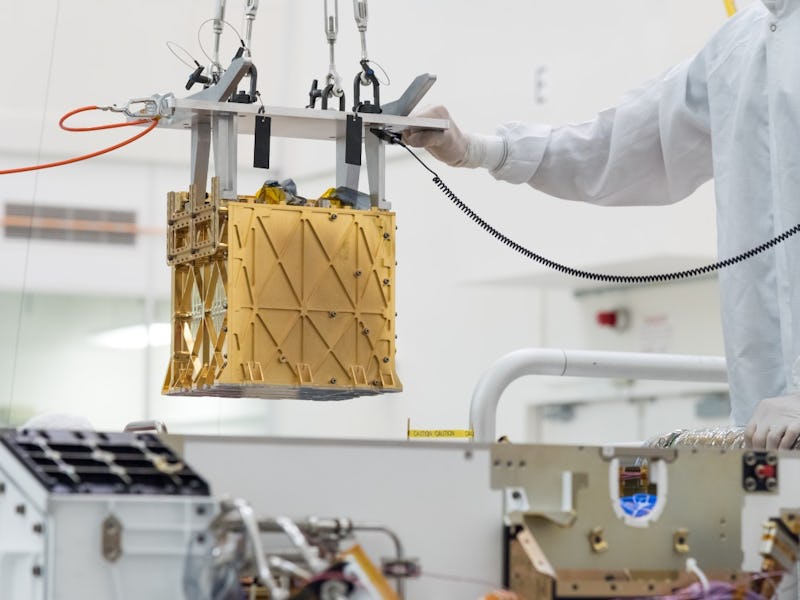The Mars Rover just took a huge step towards humans living on Mars
Perseverance successfully turned carbon dioxide into breathable oxygen in a first-of-its-kind experiment.

NASA’s Perseverance rover has been on Mars for a little more than two months and it’s already shaking things up on the Red Planet.
The SUV-sized robot performed the ultimate scientific miracle on another planet, converting carbon dioxide into oxygen. Using a toaster-sized instrument named Mars Oxygen In-Situ Resource Utilization Experiment (MOXIE), the rover inhaled some of Mars’ thin carbon dioxide atmosphere and successfully produced oxygen from it.
This proof-of-concept paves the way to creating a precious commodity on Mars: oxygen. Not only will it be useful to future astronauts looking to breathe fresh air on the planet (also reducing cargo weight in-transit), but it could be paired with hydrogen to create hydroxyzine — a powerful rocket fuel.
WHAT’S NEW — On April 20, Perseverance used MOXIE to test out this technology on another planet for the first time, converting the Red Planet’s thin, carbon-rich atmosphere into oxygen.
“MOXIE has more work to do, but the results from this technology demonstration are full of promise as we move toward our goal of one day seeing humans on Mars,” Jim Reuter, associate administrator for NASA’s Space Technology Mission Directorate, says in a statement.
The MOXIE experiment is the size of a toaster, but a future, grown-up MOXIE needs to produce a lot more oxygen to sustain a human mission on Mars.
For its first test, MOXIE produced about five grams of oxygen, or about 10 minutes worth of breathable oxygen for astronauts.
HOW THEY DID IT — MOXIE produces oxygen the same way a tree does: it breathes in carbon dioxide and exhales oxygen.
The conversion of carbon to oxygen requires a lot of heat, temperatures must reach up to approximately 1,470 degrees Fahrenheit.
MOXIE is about the size of a toaster, and is made with heat-tolerant materials like 3D-printed nickel alloy parts, which heat and cool the gases flowing through it, and a lightweight aerogel that helps hold in the heat, according to NASA.
The process works by separating oxygen atoms from carbon dioxide molecules, which are made up of one carbon atom and two oxygen atoms. After splitting the oxygen atoms from the carbon molecules, the oxygen atoms eventually combine with each other to produce molecular oxygen while carbon monoxide is emitted into the Martian atmosphere as waste.
The small unit is also coated with gold on the outside to reflect infrared heat and keep it from radiating outward. The team of engineers wanted to make sure MOXIE poses no threat to other parts of the Perseverance rover.
MOXIE is designed to produce about 10 grams of oxygen an hour.
WHY IT MATTERS — Mars’ atmosphere is made up of 96% carbon dioxide. Unfortunately for us, humans favor another type of gas. While oxygen may be crucial for humans to breathe, it also plays an important role in the production of rocket fuel.
“Oxygen isn’t just the stuff we breathe,” Reuter says. “Rocket propellant depends on oxygen, and future explorers will depend on producing propellant on Mars to make the trip home.”
In order to get a rocket off the ground, astronauts need something to burn, or fuel, and something to burn it, an oxidizer. Liquid oxygen is used as an oxidizer to create propellant.
A future human mission to Mars carrying four astronauts would require around 15,000 pounds, or 7 metric tons, of rocket fuel and 55,000 pounds, or 25 metric tons, of oxygen just to get off the Martian ground, according to NASA.
But carrying that much oxygen from Earth to Mars is not only tedious but very costly.
Therefore, designing a device like MOXIE on a larger scale is crucial for future missions to Mars, and humanity’s first time exploring another planet.
WHAT’S NEXT — Over the next two years (or the equivalent of one Martian year), MOXIE is expected to perform this process at least nine more times.
The testing will run in three phases. The first one will test out the instrument’s functionality, the second phase will test the instrument in different atmospheric conditions with varying times and seasons, while the third phase will try different modes of operation.
MOXIE is designed to release the oxygen back into the Martian atmosphere after it’s done.
But before we can venture into Mars, NASA will need to scale up MOXIE (about 100 times larger) to produce the desired 25 metric tons of oxygen, and a future, larger MOXIE will also be built to store the oxygen into tanks rather than release it back.